When I first began out in content marketing, I was both excited and apprehensive. I knew that creating great content was critical, but I soon understood that understanding how that content was performing was just as important. My first attempts to measure achievement were primitive at best. I relied on basic metrics like page visits and social shares, but I quickly realized there was a lot more to learn. In this article, I’ll discuss the most important content marketing analytics tools and metrics to track to make data-driven decisions and meet your marketing objectives.
Understanding the Value of Content Marketing Analytics
Content marketing is more than just creating and sharing content; it is about engaging your audience and achieving real results. According to the Content Marketing Institute, 72% of marketers believe that measuring content performance is crucial to overall success. It’s like trying to navigate a ship without a compass and without the proper tools and metrics.
Key Takeaways
- Defining the goals of your content marketing strategy ensures alignment with business objectives and provides direction for your efforts.
- Using a content inventory helps manage and audit all your content pieces, ensuring nothing gets overlooked.
- Monitoring performance metrics like page views, unique visitors, and bounce rates helps identify successful content and areas needing improvement.
- Tracking SEO metrics such as organic traffic, keyword rankings, and backlinks helps optimize your content for better search engine visibility.
- Keeping an eye on engagement metrics like average session duration, pages per session, and returning visitors helps understand audience interaction and content value.
Important Content Marketing Metrics to Track
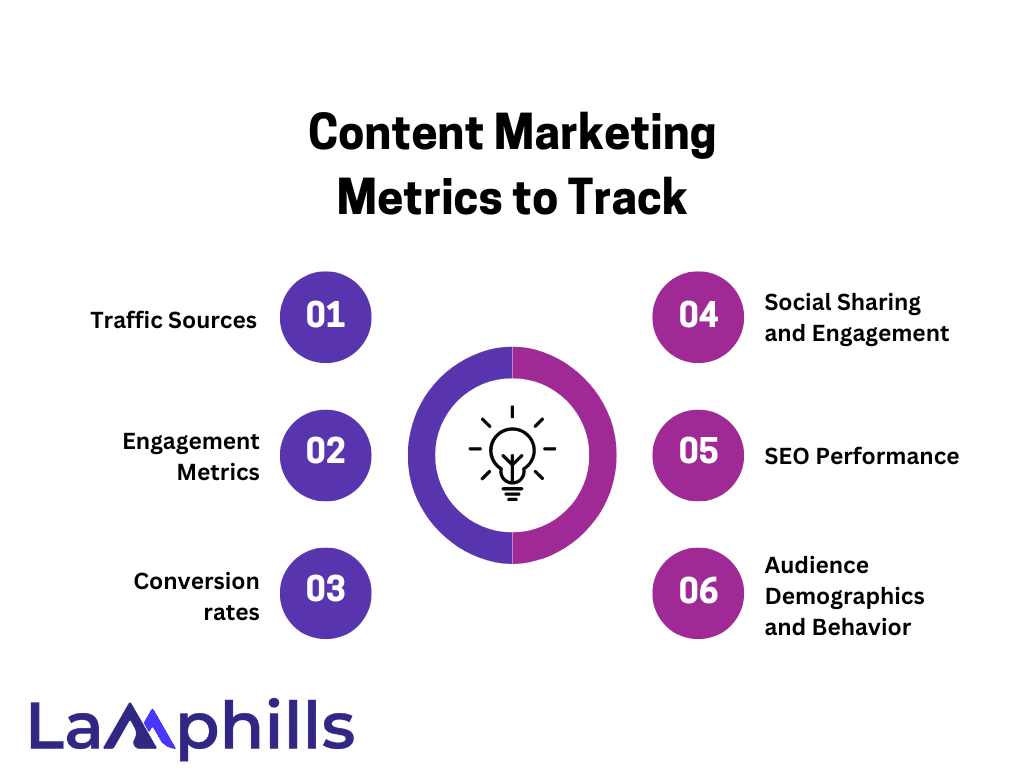
#1. Traffic Sources
Understanding where your traffic comes from is critical. Do your visitors arrive from organic search, social media, email campaigns, or direct visits? Tools like Google Analytics can provide precise information about your traffic sources.
When I started examining my traffic sources, I realized that social media accounted for a large amount of it. This realization prompted me to double down on my social media efforts, resulting in a 25% increase in overall traffic in three months.
#2. Engagement Metrics
Metrics such as bounce rate, average session duration, and pages per session show how engaged your audience is with the content. A high bounce rate may indicate that your content does not fulfill user expectations, whereas longer session durations usually imply more engaging content.
#3. Conversion rates
Conversion rates track how effectively your content encourages desired behaviors, such as signing up for a newsletter, downloading an e-book, or making a purchase. Conversion tracking and setup can be made easier with tools like Google Analytics and HubSpot.
#4. Social Sharing and Engagement
Social media analytics tools like as Hootsuite, Buffer, and native platform insights (e.g., Facebook Insights, Twitter Analytics) are critical for analyzing how your content performs on social media. Consider metrics such as shares, likes, comments, and total reach.
#5. SEO Performance
Tracking your content’s SEO performance is critical to long-term success. Ahrefs, SEMrush, and Moz are all tools that may help you understand keyword ranks, backlinks, and organic search traffic. These metrics can help you determine how well your content is optimized for search engines.
#6. Audience Demographics and Behavior
Understanding your audience and how they engage with your content is critical. Google Analytics and Facebook Insights can offer demographic information and insights into user activity. This information allows you to modify your content to better fit the demands of your intended audience.
How to Use Analytics For Content Marketing Analysis
Collecting marketing and sales data for your content marketing plan is the first step in measuring campaign performance. However, understanding how to use performance data might help you develop better content. Reviewing your data can help you discover new ways to create great content, identify the best distribution channels, and improve your current strategy.
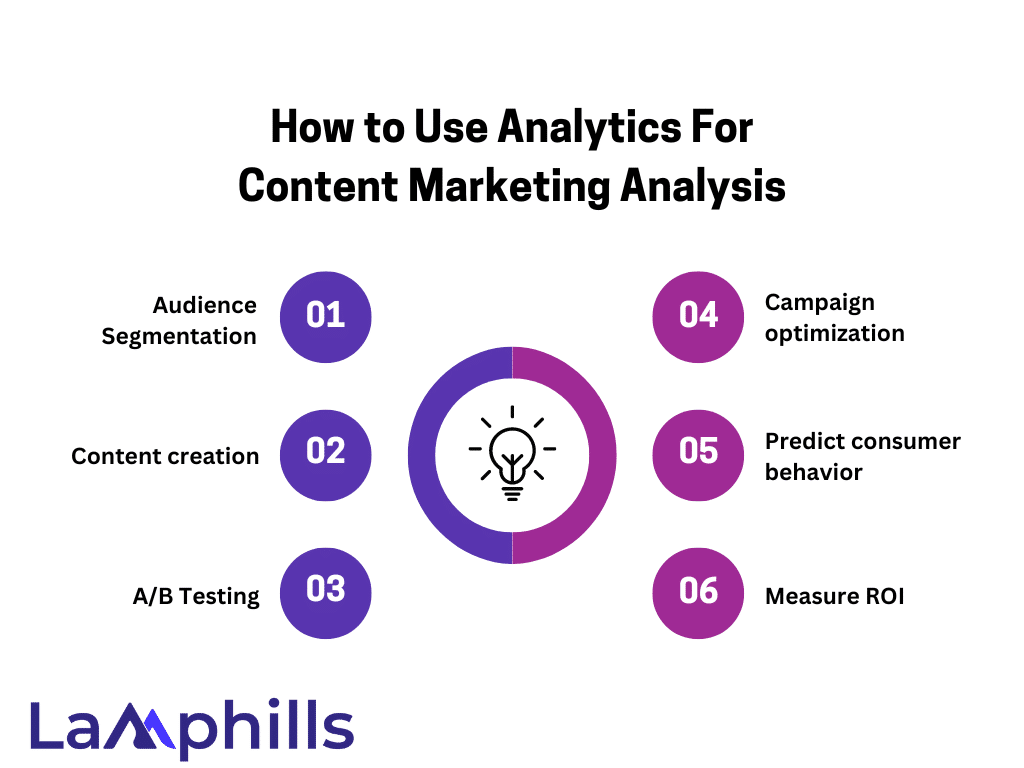
- Audience Segmentation
- Content creation
- A/B Testing
- Campaign optimization
- Predict consumer behavior
- Measure ROI
Here are a few approaches to using content analytics:
#1. Segmentation
Using powerful content analytics tools, you may divide your audience based on how they interact with your content. For example, you can categorize them based on the types of content they interact with, the frequency with which they engage, and other activities they take on your website after reading a piece of content, such as purchases, newsletter sign-ups, form submissions, and so on.
This segmentation can then be used to tailor content to each type of customer using content marketing automation. For example, if your analytics platform shows that certain segments respond better to certain types of content, you can utilize this information to further customize and target content.
#2. Content Creation
Content analytics can offer insight into the following:
- The best-performing content types.
- What types of content your target audience is most interested in.
- The many content formats with which they are most engaged.
Understanding these content preferences enables firms to generate content that their target consumers enjoy, hence improving overall engagement rates.
For example, by using Google Analytics and other analytics tools, you may discover that certain website pages perform better than others. You can go through those web pages and see which ones look to be the most engaging. Then, you may use that information to incorporate favored bits of content into your marketing strategy.
#3. A/B Testing
A/B testing cannot be performed properly without the use of a marketing analytics platform. A/B testing collects data to evaluate which version of content performs better. You can track everything from headlines to calls to action (CTAs) and images. When the test is finished, you’ll have real-time data to improve future content and marketing efforts.
In addition to A/B testing various elements, you can determine which sorts of content perform best. For example, content marketing analytics tools may advise you that an infographic on a specific topic outperformed a blog or video.
#4. Campaign optimization
Content analytics may help you optimize many areas of your marketing plan, such as the optimum times of day to post on social media and how to increase your organic search ranks on search engine results pages. You can also optimize various avenues for content dissemination, such as email marketing, your website, and social media accounts.
Marketing analytics tools can also assist you decide the optimum times to share content on social media and via email marketing. For example, your data may suggest that your target audience is most active at specific times of day or week, allowing you to tailor your schedule to maximize online visibility.
#5. Predict consumer behavior
Content marketing analytics can also help forecast consumer behavior. Identifying patterns allows predictive analysis to determine trends, audience behavior, and the future success of various forms of content. For example, you may forecast which themes will be most important to customers at a given time of year, allowing you to develop relevant content ahead of schedule.
This data can also be used to gather useful information, such as determining the optimal content formats and times to post based on previous consumer behavior data.
#6. Measure ROI
The only way to know if you’re getting the most bang for your buck in terms of marketing costs is to calculate the ROI for various campaigns and types of content. You can use a business intelligence tool to measure the value of certain pieces of content by tracking metrics such as leads, conversions, and sales.
Then, you can use this knowledge to better plan your budget, spending more on effective content and less on ineffective content.
Important Content Marketing Analytics Tools
#1. Google Analytics
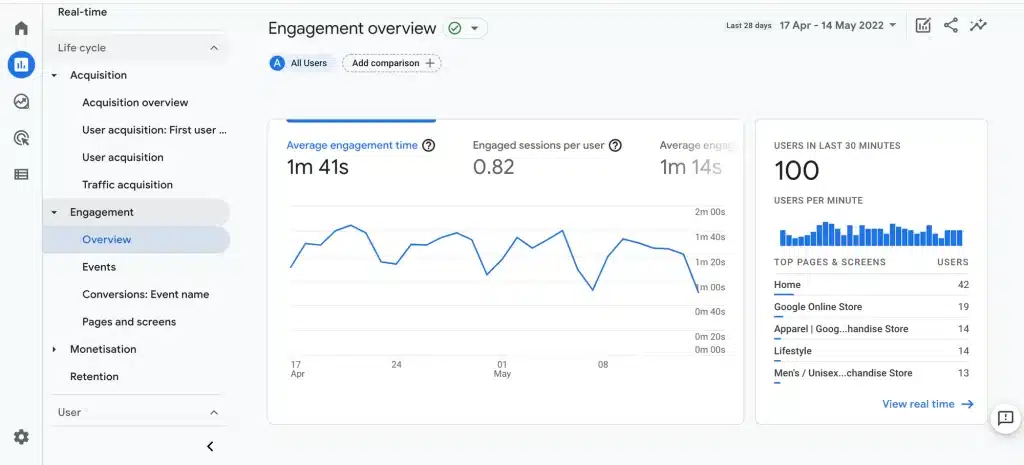
Google Analytics is a sophisticated tool for tracking a variety of metrics, including traffic sources, user behavior, and conversion rates. It’s vital for any content marketer who wants to obtain a comprehensive understanding of their audience and content performance.
Features
- Monitors website traffic, user behavior, and conversions.
- Offers extensive reports on traffic sources and audience demographics.
- Real-time analytics and configurable dashboards.
Install the Google Analytics tracking code on your website to begin gathering data about visitor interactions.
Monitor page visits, average session duration, and conversion rates with Google Analytics to track the performance of a new blog post.
Pricing: The basic version is free, whereas Google Analytics 360 costs $150,000 per year.
#2. SEMrush
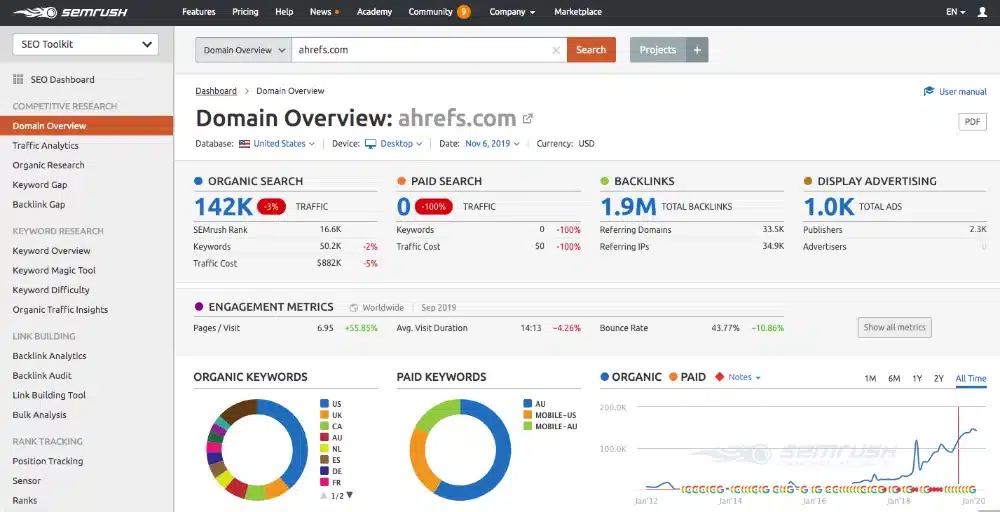
SEMrush is a comprehensive marketing solution that covers SEO, content marketing, competitive analysis, and PPC insights. It’s especially handy for watching keyword rankings and identifying potential content topics.
Features
- Complete keyword research and SEO tools.
- Competitive analysis and site auditing capabilities
- Backlink tracking and content analysis
Set up an account on SEMrush and connect your website to begin measuring your SEO and content performance.
Use SEMrush to perform a content gap analysis, identifying subjects that your competitors rank for but you do not.
Pricing: Plans begin at $119.95 per month.
#3. Ahrefs
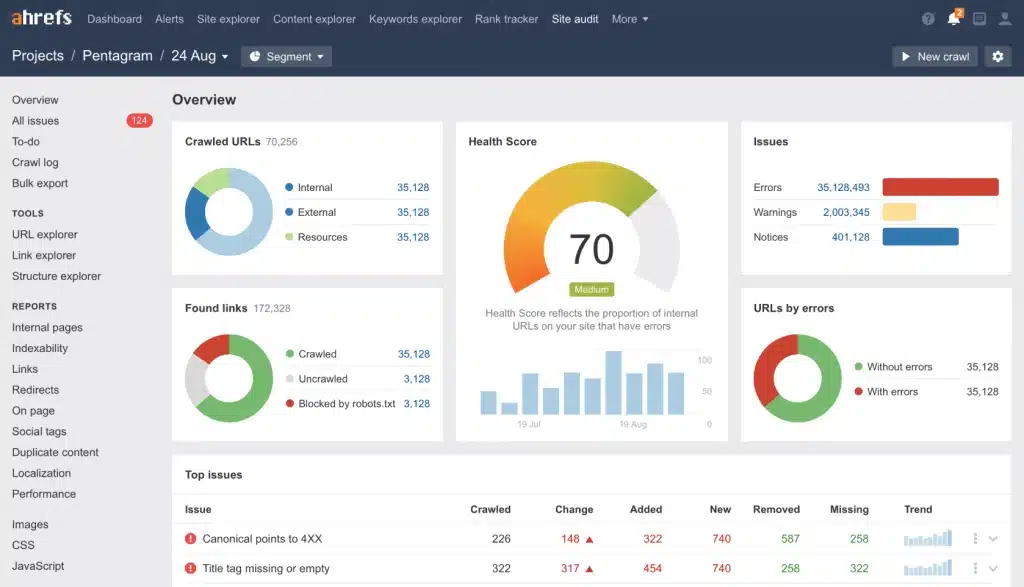
Ahrefs excels in backlink analysis and keyword research. It enables you to identify what content drives traffic to your website and how well your SEO efforts are performing.
Features
- Backlink analysis and keyword research tools
- Site Explorer for Detailed Competitive Analysis
- Use the content explorer to identify the best-performing content in your industry.
Sign up for Ahrefs and connect your website to gain access to its array of SEO tools.
Analyze your competitors’ backlink profiles to find possible link-building opportunities.
Pricing: Plans begin at $99 per month.
#4. HubSpot
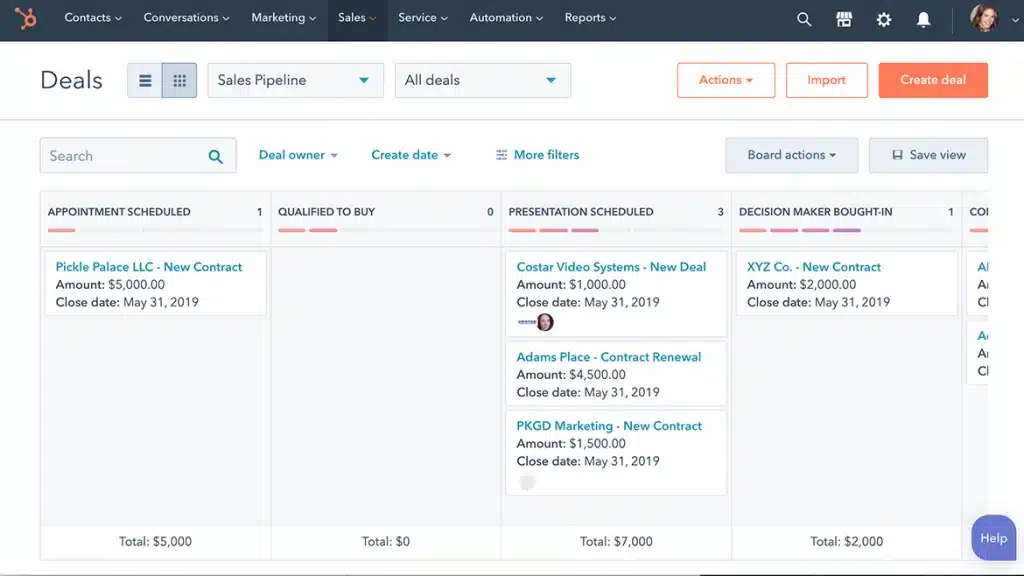
HubSpot provides a comprehensive set of content marketing tools, including analytics, SEO advice, and conversion tracking. It’s very beneficial for inbound marketing methods.
Features
- Content strategy and planning tools.
- Lead tracking and conversion analytics
- SEO advice and analytics.
Create a HubSpot account and integrate it with your website and marketing tools.
Create and track the performance of content clusters based on important subjects using HubSpot’s content strategy tool.
Pricing: Free basic plan; premium plans begin at $50 per month.
#5. BuzzSumo
BuzzSumo can help you find the most popular content on social media and uncover influencers in your niche. It’s useful for determining what forms of content resonate with your target audience.
Features
- Identifies trending content and themes.
- Analyzes social media engagement.
- Discover key influencers in your field.
Sign up for BuzzSumo and use it to find popular topics and content in your business.
Discover popular content formats and themes to help shape your content strategy.
Pricing: Plans begin at $99 per month.
#6. Hootsuite
Hootsuite is a social media management application that lets you plan posts, track engagement, and analyze performance across many platforms.
Features
- Schedule and manage social media posts.
- monitors social media participation and analytics.
- Delivers insights and reporting on social media performance.
Create an account on Hootsuite and link your social media platforms to begin managing your social media efforts.
Schedule and track the success of a social media campaign across several channels.
Pricing: Plans begin at $19 per month.
#7. Google Search Console
Google Search Console gives information about your website’s presence in Google search results. It enables you to monitor, maintain, and troubleshoot your website’s SEO performance.
Features
- Tracks website performance in Google search results.
- tracks keyword rankings and click-through rates.
- Identifies indexing issues and offers SEO recommendations.
Verify your website with Google Search Console and utilize it to track its search performance.
Monitor how individual keywords perform in search results and identify opportunities for improvement.
Pricing: Free.
#8. Crazy Egg
Crazy Egg provides heat mapping tools to help you better understand how users engage with your content. It delivers visual information on where users click, scroll, and spend the most time on your website.
Features
- Heat maps and scroll maps are used to visualize user activities.
- A/B testing capability.
- Detailed user behavior reports
Install the Crazy Egg tracking script on your website and begin gathering heat map data.
Use heat maps to see where users are clicking and scrolling, then make changes to improve the user experience.
Pricing: Plans begin at $24 per month.
#9. Canva
Canva is a graphic design application that helps you create visually appealing content. It’s especially great for making infographics, social media postings, and other visual elements to complement your content.
Features
- A user-friendly graphic design tool
- Templates for social media postings, infographics, and more.
- Collaboration features for team projects.
Create a Canva account and utilize the templates to create graphic content for your marketing campaigns.
Create compelling social media visuals to complement your blog posts and increase shareability.
Pricing: Canva Pro starts at $12.95 a month, while the basic plan is free.
#10. Trello
Trello is a project management application that can help you organize and streamline the content creation process. It’s ideal for collaboration and keeping track of your content schedule.
Features
- Project management and task organization tool
- Customizable boards, lists, and cards.
- Collaboration features for team projects.
Create a Trello board to manage your content calendar and workflows.
Organize your content creation process by making lists of ideas, in-progress content, and published articles.
Pricing: Trello Business Class starts at $9.99 per user per month, while the basic plan is free.
How to Implement These Tools
To properly apply these tools, begin by establishing specific goals for your content marketing initiatives. Having precise objectives, whether they be to increase traffic, improve engagement, or drive conversions, will help lead your analytics strategy.
In my early days, I struggled to comprehend which metrics were genuinely important. By gradually introducing tools such as Google Analytics and SEMrush into my workflow, I began to notice patterns and insights that helped me fine-tune my strategy. For example, using SEMrush, I noticed that my top-performing content was constantly optimized for specific long-tail keywords, prompting me to increase my attention on keyword research and optimization.
Content Marketing Analytics Template
An organized approach to content marketing analytics is essential for tracking and optimizing your content strategy. A well-designed template can help you speed the process, ensuring that you capture all relevant data and make educated decisions. Our free content marketing analytics template is available for download below.
Conclusion
Tracking the correct content marketing metrics and utilizing the right tools can significantly improve your marketing success. Understanding and adopting these methods allows you to develop more engaging content, deliver greater results, and meet your business objectives. Are you prepared to elevate your content marketing analytics to the next level?
Related Articles
- Content Team: How to Build & Grow an Effective Content Team
- What Is Creative Content? All You Need 2024
- CONTENT MARKETING: A User-Guide to Developing Your Business
- I Doubled My Traffic Overnight By Using This Curated Content Hack
- 6 Keyword Marketing Hacks For Dominating Google Rankings






